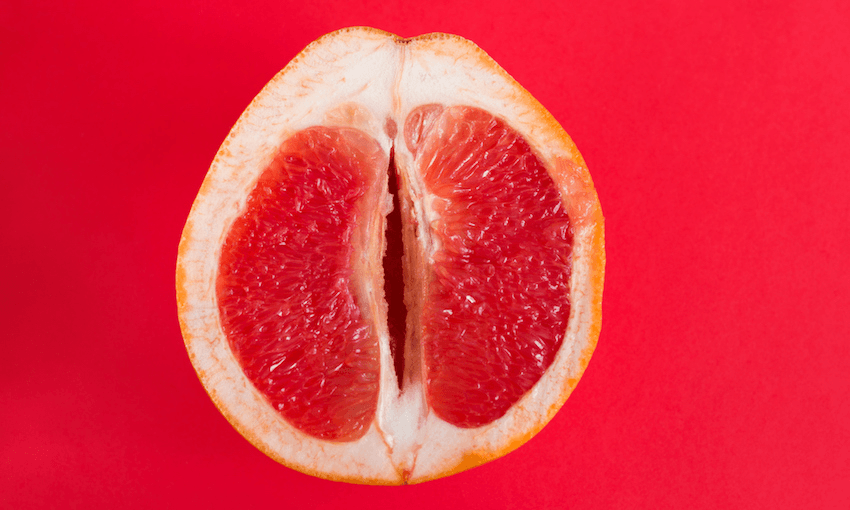Alex Casey goes on a journey to find out all there is to know about what a “normal” vulva looks like. Spoiler alert: there are many, many versions of normal.
The funniest and most embarrassing thing anyone has ever said to me in my whole life happened during my very first smear test. I was lying there, terrified, serving Donald Ducking realness in just a t-shirt and no pants, when the nurse pulled out a speculum that was approximately the size of the drill they used to make the Waterview tunnel. She brandished it like a mad scientist, looked me in the eye, and said this:
“You’ve had kids, right?”
I burst out laughing in the really loud, bracing kind of a way that, say, Joaquin Phoenix’s Joker might’ve. Reader, I have not had kids. Not even once. I was so shocked in the moment that I didn’t ask her why she thought that, choosing instead to mull over it at 2am every night for about two or three years like the cool, confident woman that I am. Was it the size? Shape? General vibe? The fact that my hair was tied up in a messy bun and I looked like I hadn’t slept in weeks?
My insecurities weren’t helped by the fact that we don’t really get to see depictions of regular people’s vulvas anywhere. Where toilet walls worldwide are littered with cock and balls of varying size, girth and hairiness, my friends and I had to drink two bottles of wine each before drawing pictures of our vulva for each other to examine before shredding the evidence and swearing never to speak of it again – especially not in a piece on the internet.
It is with all of this in mind that I decided to call Dr Beth Messenger, national medical advisor for Family Planning, to ask her every question I could think of when it comes to the mighty vulva.
Alex: I’m 28 and I still don’t know the difference between the vagina and the vulva. Help?
Dr Beth: The vagina is the internal part and the vulva is the external folds of skin – it’s made up of the hair-bearing skin called the labia majora and then you have the inner lips which are the labia minora. The whole external bit is the vulva. So when people talk about how they don’t like the way that their vagina looks, they aren’t talking about their vagina at all – they are talking about their vulva. You normally need something like a plastic speculum used in a smear test to technically see the vagina. If you can see your vagina, well, that’s something called a prolapse which is something totally different altogether.
You’ve obviously seen thousands of vulva in your professional career, is everyone as insecure about theirs as I am about mine?
We do occasionally get people who see us because they are unhappy with the appearance of things down there. Usually, when we have a look, everything still looks normal, but because most people don’t really get to look that closely at anybody’s else, they’ve really only got their own to compare to. That’s the big problem with modern pornography – often what you are looking at isn’t normal. They can airbrush vulvas just like they can airbrush faces.
Pornography also appears to have had an influence on the rise in cosmetic labiaplasty, is that something you have seen?
We do get people asking for referrals, but only a few of them are purely cosmetic. There are cases of the labia minora being excessively large and getting caught in underwear and during sex in a way that can be painful, so we refer people onto gynaecology in those instances. If large labia are causing pain problems, then surgery might be an option there. I do find it disturbing that, internationally, we condemn female genital mutilation and yet people here are seeking out an equivalent cosmetic procedure so that they can look more “normal”. This lack of knowing what “normal” actually means is driving people to these unnecessary procedures.
So tell me, as someone who has seen thousands – what is a normal vulva?
There’s an enormous amount of variation that we consider ‘normal’ and there aren’t many things that surprise me these days. When we talk about normal vulva, we want to emphasise that normal is a real range. You can have very minimal development of both the labia minora and the labia majora, so you won’t see much in terms of folds of skin, or you can have more. They are both normal.
With that said, It’s also important to note that some things are abnormal. Things like changes in skin condition, eczema, psoriasis, vulval cancers as well as warts and herpes – there’s a whole range of conditions that require treatment. If you are worried that your vulva isn’t normal – whether it is different from before or whether something just doesn’t feel right, then go to someone who does examinations a lot and ask them to have a look.
There’s a lot of things happen to so many of us that we think we can’t do anything about. People don’t talk about less glamorous things like vaginal dryness or leaking urine – women will put up with an amazing amount because they think it’s normal. If you think there’s actually something wrong you shouldn’t be sitting on it but, at the same time, if it is normal then it can be really reassuring to know that you don’t need to do anything different.
And now, brief word from a woman with a neo-vagina:
My relationship with my vulva is a little bit complicated. It’s great because it is not a penis anymore, but it’s not exactly like a cis vulva and I am very aware of that, which can sometimes be a bit dysphoric. I would actually like bigger labia because I associate that with being a cis woman. It scares me that in pornography they edit out natural labia – I find that very freaky.
The most important thing to know about having a trans vagina is that things can go wrong with it that you might not see with a cis vagina. Because of the way that a neo-vagina is constructed, you can sometimes get hair in places where you don’t want and ingrown hairs which might appear to look like an STI. The best thing to do is go and see a doctor if you have any concerns.
The tissue is also much more delicate than a cis vagina, so there can sometimes be bleeding, infections and tearing after penetrative sex. Grazed tissue under the skin can sometimes be misconstrued for an STI, and people with a neo-vagina are at increased risk of STIs. If you are very sexually active with multiple sexual partners, you should be getting checked up more regularly.
More generally, the hygiene and upkeep of a neo-vagina is quite different to a cis vagina. You do have to clean and douche it more using warm water because it is not self-cleaning. It is a higher maintenance beast for sure, but I always just have to remind myself that it is still a thousand times better than what I used to have.
Alex: How gnarly is the effect of childbirth on the vulva? What can people expect?
Dr Beth: It completely depends on how straightforward the birth is. If the birth is straightforward and the delivery of the head is really controlled, the skin stretches enough. It’s amazing how much the skin can stretch down there – if that all goes perfectly then it’s possible there is no tear, no stitches. Don’t get me wrong, it’s going to feel tender, but it should heal up nicely. Some describe feeling looser or larger, particularly the inner folds, after giving birth.
Obviously, if there’s been a cut or a tear during the birth, which is also common, that’s going to be a completely different situation. Sometimes things have not healed so well after babies were born, so repair is needed around that where the wound stitches haven’t been pulled together neatly or have broken down. Sometimes there are too many stitches too, so there’s really a huge variety in what is both normal and abnormal after birth.
The other thing to keep in mind for later down the track is that after menopause, the vulval skin actually becomes much drier and tighter, and you tend to see it all becoming smaller. That’s the other thing that is really important to keep in mind throughout your life – your vulva changes over time depending on where you are at in terms of your life stage and having babies, and so if things feel different that isn’t necessarily abnormal either.
There’s a whole aisle in the Chemist Warehouse dedicated to weird feminine hygiene products – do we need them? And what about waxing the vulva? Is it fine?
It’s skin and you need to look after it, and actually that is what your pubic hair is for. Hair is for protection and we do see a whole pile of problems because people have removed the hair from their vulva. Things like ingrown hairs are a big issue, and waxing can actually damage the internal structure of the skin which can make your vulva look much older, much earlier. I don’t think your waxer will tell you that, but it is definitely something we see.
We’ve definitely been through a time where seeing pubic hair was a rare thing. But it’s much more normal again to see pubic hair. For a while we didn’t see any and when we told people the source of their problems down there was from shaving or waxing, they were horrified because they felt as if the idea of having hair down there again would make them abnormal. These days, we are definitely seeing a shift back and more and more pubic hair.
As for hygiene products, warm water is all you need. You don’t need any of those other products but, if you think you do, it is better to use something designed to work down there, because things like soap can really upset the bacterial balance in the vagina. Wear cotton underwear, avoid wearing too many tight clothes – a lot of that is really about vaginal health rather than vulval health, but it all helps the overall condition of the vulval skin.
And in terms of getting people feeling better about their own vulva, are there healthy representations that we can seek out anywhere?
It’s difficult because a lot of parents have moved away from allowing their small children to see them naked because nudity has become so sexualised. So now we see children who don’t know what normal adult bodies look like either, and then, later on, they have nothing to compare themselves to apart from the images they can find online. As we know, normal bodies are much harder to access online than bodies in pornography.
There have been projects like The Great Wall of Vagina, where somebody went around and took plaster casts of various vulva, which really demonstrate the glorious variation. I think most people don’t even know what their own vulva looks like – it’s not going to be for everybody, but it can be useful to pop a mirror down there. There’s certainly a lot of expectation around the idea of perfection these days and the vulva has not escaped that. But that doesn’t mean that we don’t see an incredibly wide range of vulva and that what you have isn’t normal.
This content was created in paid partnership with Women’s Health Action. Learn more about our partnerships here.

